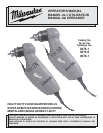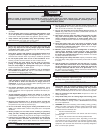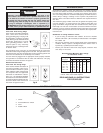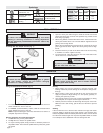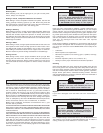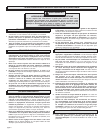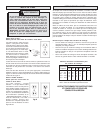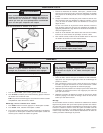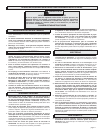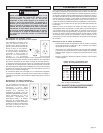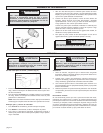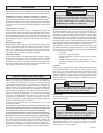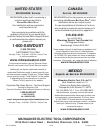
page 5
Maintaining Tools
Keep your tool in good repair by adopting a regular maintenance pro-
gram. Before use, examine the general condition of your tool. Inspect
guards, switches, tool cord set and extension cord for damage. Check
for loose screws, misalignment, binding of moving parts, improper mount-
ing, broken parts and any other condition that may affect its safe opera-
tion. If abnormal noise or vibration occurs, turn the tool off immediately
and have the problem corrected before further use. Do not use a dam-
aged tool. Tag damaged tools “DO NOT USE” until repaired
(see “Repairs”).
Under normal conditions, relubrication is not necessary until the motor
brushes need to be replaced. After six months to one year, depending on
use, return your tool to the nearest MILWAUKEE service facility for the
following:
• Lubrication
• Brush inspection and replacement
• Mechanical inspection and cleaning (gears, spindles, bearings,
housing, etc.)
• Electrical inspection (switch, cord, armature, etc.)
• Testing to assure proper mechanical and electrical operation
Cleaning
Clean dust and debris from vents. Keep the tool handles clean, dry and
free of oil or grease. Use only mild soap and a damp cloth to clean your
tool since certain cleaning agents and solvents are harmful to plastics
and other insulated parts. Some of these include: gasoline, turpentine,
lacquer thinner, paint thinner, chlorinated cleaning solvents, ammonia
and household detergents containing ammonia. Never use flammable or
combustible solvents around tools.
MAINTENANCE
ACCESSORIES
WARNING!
To reduce the risk of injury, always unplug
your tool before performing any maintenance.
Never disassemble the tool or try to do any
rewiring on the tool's electrical system. Contact
a MILWAUKEE service facility for ALL repairs.
WARNING!
To reduce the risk of injury, electric shock and
damage to the tool, never immerse your tool in
liquid or allow a liquid to flow inside the tool.
WARNING!
To reduce the risk of injury, always unplug the
tool before attaching or removing accessories.
Use only specifically recommended accesso-
ries. Others may be hazardous.
APPLICATIONS
Selecting Bits
When selecting a bit, use the right type for your job. For best perfor-
mance, always use sharp bits.
Drilling in Wood, Composition Materials and Plastic
When drilling in wood, composition materials and plastic, start the drill
slowly, gradually increasing speed as you drill. When using twist drill
bits, pull the bit out of the hole frequently to clear chips from the bit flutes.
Use low speeds for plastics with a low melting point.
Drilling in Masonry
When drilling in masonry, use high speed carbide-tipped bits. Drilling soft
masonry materials such as cinder block requires little pressure. Hard
materials like concrete require more pressure. A smooth, even flow of
dust indicates the proper drilling rate. Do not let the bit spin in the hole
without cutting. Do not use water to settle dust or to cool bit. Both actions
will damage the carbide.
Drilling in Metal
When drilling in metal, use high speed steel twist drills or hole saws. Use
slow speeds for hard metals and high speeds for softer metals. Lubri-
cate drill bits with cutting oil when drilling in iron or steel. Use a coolant
when drilling in nonferrous metals such as copper, brass or aluminum.
Back the material to prevent binding and distortion on breakthrough.
Driving Screws
When driving screws, use the proper screwdriver bit for your job. After
drilling pilot and shank holes, start the screw slowly and increase the
speed as driving progresses. Set the screw by slowing to a stop. Do not
run screws down at excessive speeds. To remove screws, reverse the
motor.
FIVE YEAR TOOL LIMITED WARRANTY
Every MILWAUKEE tool is tested before leaving the factory and is war-
ranted to be free from defects in material and workmanship. MILWAUKEE
will repair or replace (at MILWAUKEE’s discretion), without charge, any
tool (including battery chargers) which examination proves to be defec-
tive in material or workmanship from five (5) years after the date of
purchase. Return the tool and a copy of the purchase receipt or other
proof of purchase to a MILWAUKEE Factory Service/Sales Support
Branch location or MILWAUKEE Authorized Service Station, freight pre-
paid and insured. This warranty does not cover damage from repairs
made or attempted by other than MILWAUKEE authorized personnel,
abuse, normal wear and tear, lack of maintenance, or accidents.
Battery Packs, Flashlights, and Radios are warranted for one (1) year
from the date of purchase.
THE REPAIR AND REPLACEMENT REMEDIES DESCRIBED HEREIN ARE
EXCLUSIVE. IN NO EVENT SHALL MILWAUKEE BE LIABLE FOR ANY
INCIDENTAL, SPECIAL, OR CONSEQUENTIAL DAMAGES, INCLUDING
LOSS OF PROFITS.
THIS WARRANTY IS EXCLUSIVE AND IN LIEU OF ALL OTHER WARRAN-
TIES, OR CONDITIONS, WRITTEN OR ORAL, EXPRESSED OR IMPLIED FOR
MERCHANTABLILITY OR FITNESS FOR PARTICULAR USE OR PURPOSE.
This warranty gives you specific legal rights. You may also have other
rights that vary from state to state and province to province. In those
states that do not allow the exclusion of implied warranties or limitation
of incidental or consequential damages, the above limitations or exclu-
sions may not apply to you. This warranty applies to the United States,
Canada, and Mexico only.
Repairs
If your tool is damaged, return the entire tool to the nearest service
center.
For a complete listing of accessories refer to your MILWAUKEE Electric
Tool catalog or go on-line to www.milwaukeetool.com. To obtain a
catalog, contact your local distributor or a service center.



